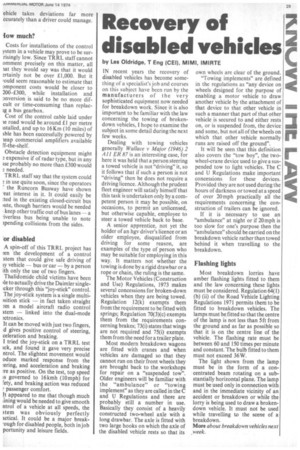Recovery of disabled vehicles
Page 31

If you've noticed an error in this article please click here to report it so we can fix it.
by Les Oldridge, T Eng (CE1), MIMI, 1MIRTE IN recent years the recovery of disabled vehicles has become something of a specialist's job and courses on this subject have been run by the manufacturers of the very sophisticated equipment now needed for breakdown work. Since it is also important to be familiar with the law concerning the towing of brokendown vehicles, I hope to examine the subject in some detail during the next few weeks.
Dealing with towing vehicles generally Wallace v Major (1946) 2 All ER 87 is an interesting case, for here it was held that a person steering a towed vehicle is not "driving" it, so it follows that if such a person is not "driving" then he does not require a driving licence. Although the prudent fleet engineer will satisfy himself that this task is undertaken only by a competent person it may be possible, on occasions, to permit an unlicensed, but otherwise capable, employee to steer a towed vehicle back to base.
A senior apprentice, not yet the holder of an hgv driver's licence or an older employee, disqualified from driving for some reason, are examples of the type of person who may be suitable for employing in this way. It matters not whether the towing is done by a rigid drawbar or a rope or chain, the ruling is the same.
The Motor Vehicles (Construction and Use) Regulations, 1973 makes several concessions for broken-down vehicles when they are being towed. Regulation 12(k) exempts them from the requirement to be fitted with springs; Regulation 70(3)(c) exempts them from the requirements concerning brakes; 73(i) states that wings are not required and 75(i) exempts them from the need for a trailer plate.
Most modern breakdown wagons are fitted with cranes and when vehicles are damaged so that they cannot run on their front wheels they are brought back to the. workshops for repair on a "suspended tow". Older engineers will be familiar with the "ambulance" or "towing implement" as they are called in the C and U Regulations and there are probably still a number in use. Basically they consist of a heavily constructed two-wheel axle with a long drawbar. The axle is fitted with two large hooks on which the axle of the disabled vehicle rests so that its own wheels are clear of the ground.
"Towing implements" are defined in the regulations as "any device on wheels designed for the purpose of enabling a motor vehicle to draw another vehicle by the attachment of that device to that other vehicle in such a manner that part of that other vehicle is secured to and either rests on, or is suspended from, the device and some, but not all of the wheels on which that other vehicle normally runs are raised off the ground".
It will be seen that this definition also covers the "tow boy", the twowheel-crane device used to give a suspended tow to light vehicles. The C and U Regulations make important concessions for these devices. Provided they are not used during the hours of darkness or towed at a speed of over 20 mph practically all the requirements concerning the construction of trailers can be ignored.
If it is necessary to use an "ambulance" at night or if 20 mph is too slow for one's purpose then the "ambulance" should be carried on the breakdown vehicle rather than towed behind it when travelling to the breakdown.
Flashing lights
Most breakdown lorries have amber flashing lights fitted to them and the law concerning these lights must be considered. Regulation 64(1) (b) (ii) of the Road Vehicle Lighting Regulations 1971 permits them to be fitted to breakdown vehicles. The lamps must be fitted so that the centre of the lamp is not less than 5ft from the ground and as far as possible so that it is on the centre line of the vehicle. The flashing rate must be between 60 and 150 times per minute and constant. The bulb fitted to them must not exceed 36W.
The light shown from the lamp must be in the form of a concentrated beam rotating on a substantially horizontal plane. The lamp must be used only in connection with and in the immediate vicinity of an accident or breakdown or while the lorry is being used to draw a brokendown vehicle. It must not be used while travelling to the scene of a breakdown.
More about breakdown vehicles next _week.




























































































































